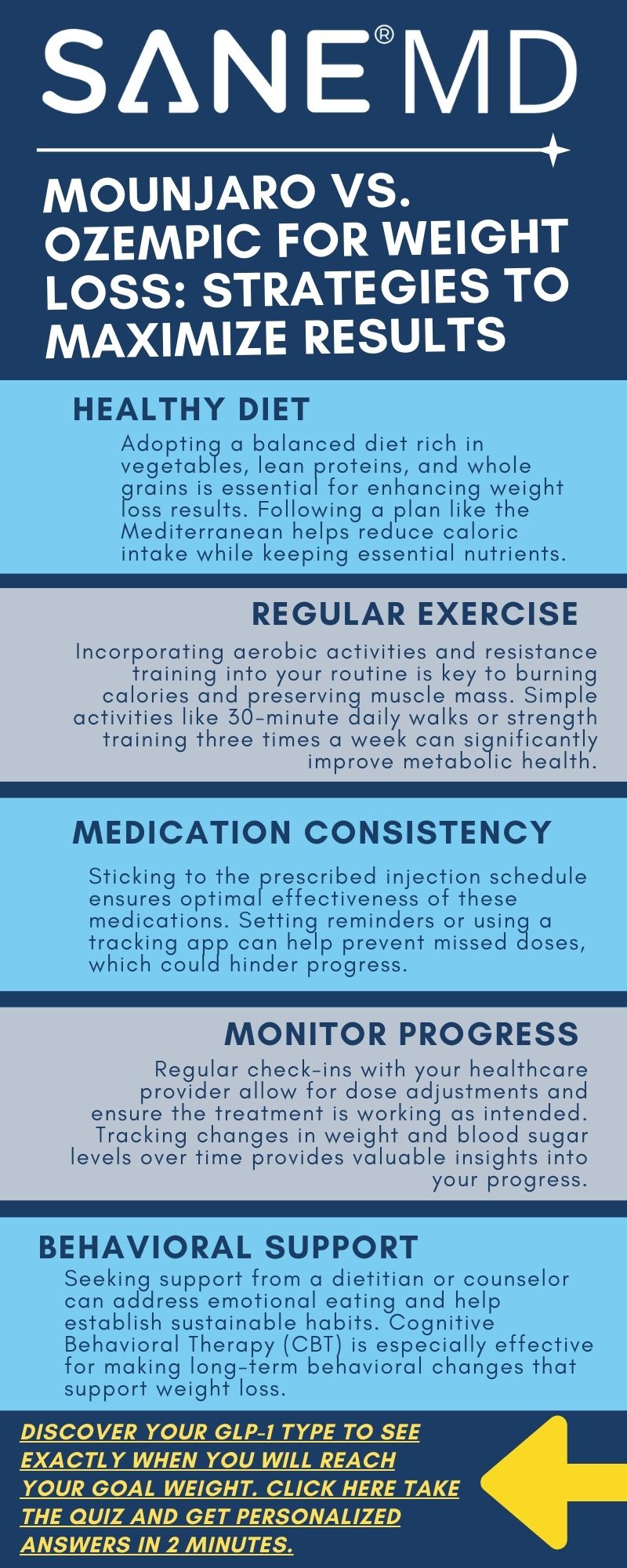Mounjaro vs. Ozempic for Weight Loss: A Comprehensive Comparison
Dr. Matthew Olesiak, MD, is the Chief Medical Director at SANESolution, a renowned wellness technology company dedicated to providing evidence-based solutions for optimal living. Dr. Olesiak earned his medical degree from the prestigious Jagiellonian University Medical College in Kraków, Poland, where he developed a strong foundation in medicine.
Weight management has become a growing concern worldwide, with obesity contributing to increased risks of cardiovascular disease, diabetes, and other chronic conditions. Among the latest advancements in weight loss drugs, Mounjaro and Ozempic have emerged as two promising options.
Many individuals are trying to decide between Mounjaro vs. Ozempic for weight loss. Both GLP-1 medications, primarily developed to manage diabetes, have shown the potential to support significant weight loss.
This article provides a detailed comparison of these medications, exploring their mechanisms, benefits, side effects, and strategies to maximize their efficacy.
Key Takeaways
- Mounjaro and Ozempic are much-prescribed options for weight loss and diabetes management. While both medications primarily target blood sugar control, they offer substantial benefits in helping compatible patients lose weight, with Mounjaro showing slightly greater weight loss potential in studies. For those wondering how Mounjaro compares to its weight loss counterpart, Zepbound, check out our article: Is Zepbound the Same as Mounjaro?
- Each medication has unique advantages tailored to specific needs: Mounjaro’s dual receptor action targets multiple metabolic pathways, while Ozempic offers proven cardiovascular benefits and a long-standing safety record.
- Lifestyle modifications are essential for optimal results: Combining these medications with a healthy diet, regular exercise, and behavioral support maximizes their effectiveness and promotes sustainable weight management.
Overview of Mounjaro and Ozempic
Mounjaro and Ozempic belong to a class of diabetes drugs known as receptor agonists.
While their primary purpose is to manage blood sugar levels, their impact on weight loss has garnered significant attention.
- Mounjaro (Tirzepatide): Developed by Eli Lilly, this medication is a dual receptor agonist that targets both glucose-dependent insulinotropic polypeptide (GIP) and glucagon-like peptide-1 (GLP-1) receptors. This dual action helps control blood sugar while promoting weight loss by enhancing satiety and reducing calorie intake. Note that Mounjaro is FDA-approved only for blood sugar control, while Zepbound
- Ozempic (Semaglutide): A GLP-1 receptor agonist, Ozempic primarily focuses on stimulating insulin production, lowering blood sugar levels, and reducing appetite. It has been widely studied for its efficacy in supporting weight loss among obese adults.
Mechanisms of Action
Understanding how these drugs work is essential for evaluating their effectiveness in weight loss and blood sugar control.
- Mounjaro: By targeting both GIP and GLP-1 receptors, Mounjaro enhances insulin secretion in response to meals, reduces glucagon levels, and delays gastric emptying. This results in fewer calories consumed and greater weight loss. Additionally, it influences the brain’s reward system, reducing cravings and supporting long-term adherence to healthier eating habits.
- Ozempic: As a GLP-1 receptor agonist, Ozempic primarily stimulates insulin production and lowers glucagon secretion. Its effect on delaying gastric emptying also contributes to a feeling of fullness, aiding weight loss. Ozempic also helps regulate appetite by acting on brain centers involved in hunger and satiety.
Clinical Trials and Efficacy
Numerous clinical trials have highlighted the effectiveness of Mounjaro and Ozempic in promoting weight loss and managing diabetes.
- Mounjaro: In studies, patients taking Mounjaro lost up to 22.5% of their body weight. This significant weight loss has positioned it as a valuable option for a subset of obese adults seeking both weight management and blood sugar control. Research published in the New England Journal of Medicine confirmed these results, emphasizing the potential of Mounjaro as a dual-action therapy.
- Ozempic: Clinical trials have demonstrated that Ozempic can result in a weight reduction of 15-20% when combined with a healthy diet and exercise. Its once-weekly semaglutide formulation ensures sustained efficacy, making it a popular choice for long-term weight management. The cardiovascular benefits highlighted in studies make it particularly suitable for patients at risk of heart disease.Mounjaro vs. Ozempic Comparison
Feature Mounjaro Ozempic Target Receptors Dual action on GIP and GLP-1 receptors GLP-1 receptor specificity Weight Loss Potential Up to 22.5% weight loss in clinical trials 15-20% weight loss in clinical trials FDA Approval Approved for diabetes, prescribed off-label for weight loss Approved for diabetes, prescribed off-label for weight loss Cardiovascular Benefits Improves cardiovascular health (limited data) Proven cardiovascular benefits Dosing Frequency Once-weekly injection Once-weekly injection Safety Record Newer drug with emerging safety profile Long-standing safety record
Key Differences Between Mounjaro and Ozempic
In analyzing Mounjaro vs. Ozempic we find that, while both medications are effective, they have distinct features that set them apart:
- Target Receptors: Mounjaro’s dual action on GIP and GLP-1 receptors offers a broader mechanism of action compared to Ozempic’s GLP-1 specificity.
- Weight Loss Potential: Mounjaro has shown more weight loss in clinical trials, making it a preferred choice for patients focusing on significant weight reduction.
- FDA Approval: While both drugs are FDA-approved for managing diabetes, they are prescribed off-label for weight loss.
- Side Effects: The profile of side effects differs, as detailed below.
Benefits of Using Mounjaro and Ozempic
Both medications offer several advantages beyond weight loss:
- Improved Blood Sugar Control:
- Mounjaro’s dual receptor action enhances the body’s ability to lower blood sugar levels, reducing the risk of diabetes complications.
- Ozempic’s GLP-1 specificity effectively improves blood sugar control in type 2 diabetes patients.
- Reduction in Cardiovascular Risk:
- Studies have shown that both medications can lower the risk of major cardiovascular events, such as heart attacks and strokes.
- Convenient Dosing:
- Both drugs are administered via a once-weekly injection, offering simplicity and adherence for patients.
Side Effects and Risks
GLP-1 medications’ side effects are well documented, and Mounjaro and Ozempic are no different. Both have side effects that patients and healthcare providers must consider:
- Mounjaro:
- Nausea and Diarrhea: Common during dose escalation but typically diminish over time.
- Gastrointestinal Problems: Including abdominal pain and constipation.
- Serious Adverse Events: Rare but may include pancreatitis or medullary thyroid carcinoma.
- Allergic Reactions: Manifesting as rash or difficulty breathing.
- Ozempic:
- Nausea and Diarrhea: Frequently reported, particularly at higher doses.
- Bowel Obstruction: Though rare, it can occur in some patients.
- Cardiovascular Events: Reduced risk of major cardiovascular events, such as heart attack and stroke, in patients with diabetes.
- Medullary Thyroid Carcinoma: A rare but serious risk associated with GLP-1 receptor agonists.
Insurance Coverage and Cost
The affordability of weight loss drugs often depends on insurance coverage:
- Mounjaro: Coverage varies, with some plans requiring prior authorization. Out-of-pocket costs can be high without insurance. Eli Lilly offers patient assistance programs to make the drug more accessible.
- Ozempic: Widely covered for diabetes but less commonly approved for weight loss. Patients prescribed off-label may face higher costs. Novo Nordisk, the manufacturer, also provides support for eligible patients.
Strategies to Maximize Weight Loss Results
Both Mounjaro and Ozempic work best when combined with lifestyle modifications:
- Healthy Diet: Adopting a balanced diet rich in vegetables, lean proteins, and legumes can enhance weight loss results. Limiting processed foods and added sugars further supports weight management. For example, patients might follow a Mediterranean or DASH diet tailored to reduce caloric intake while maintaining nutritional balance.
- Regular Exercise: Incorporating aerobic and resistance training helps burn calories and maintain muscle mass. Physical activity also improves overall metabolic health. Structured routines, such as 30-minute daily walks or strength training sessions three times a week, can significantly boost results.
- Consistency in Medication: Adhering to the prescribed schedule ensures optimal efficacy. Missing doses can reduce the effectiveness of both medications.
- Monitoring Progress: Regular check-ins with a healthcare provider allow for dose adjustments and address potential adverse events. Electronic health records can track changes in body weight and blood sugar levels over time.
- Behavioral Support: Working with a dietitian or counselor can help address emotional eating and build sustainable habits. Cognitive-behavioral therapy (CBT) has proven effective in supporting long-term weight management.
Practical Tips for Taking Mounjaro and Ozempic
To ensure the best outcomes, patients should consider the following:
- Injection Sites: Administering the medication in the upper arm, thigh, or abdomen ensures proper absorption. Rotating sites can reduce irritation and prevent the development of lumps or scar tissue. It’s recommended to choose a site that is comfortable and easily accessible, and to clean the area thoroughly with an alcohol swab before injection.
- Dose Escalation: Starting with a low dose minimizes side effects such as nausea or dizziness. Healthcare providers typically recommend a gradual increase over weeks to allow the body to adjust to the medication. Patients should follow their provider’s dosing schedule precisely, as skipping dose escalations or increasing too quickly can lead to more pronounced side effects.
- Symptom Management: Common side effects like nausea and diarrhea can be addressed with simple strategies. Eating smaller, more frequent meals can prevent an overly full stomach, which often exacerbates symptoms. Avoiding greasy, fried, or heavily spiced foods can also help. Staying hydrated and incorporating bland foods, such as crackers or bananas, may alleviate gastrointestinal discomfort.
- Communication: Open and regular communication with a healthcare provider is essential. Patients should report any side effects, no matter how minor, to allow timely intervention. Providers can adjust doses, recommend additional treatments, or suggest over-the-counter remedies to improve the patient’s experience. It’s important for patients to notify their healthcare provider about any other medications or supplements they are currently taking to prevent possible interactions.
- Establishing a Routine: Setting reminders for weekly injections can ensure consistency. Using a calendar or app to track doses can prevent missed or late injections, which may reduce the medication’s effectiveness. Maintaining a routine also helps patients monitor their progress and remain committed to their treatment plan.
- Mental and Emotional Support: Adjusting to a new medication regimen can be overwhelming. Seeking support from healthcare professionals, family, or support groups can help patients navigate challenges. Understanding that side effects often diminish over time can provide reassurance and encouragement to stay on track.
- Storage and Handling: Both Mounjaro and Ozempic require proper storage to maintain effectiveness. They should be kept in a refrigerator but not frozen. If traveling, patients can use insulated bags or cold packs to ensure the medication stays at the appropriate temperature. Before injection, letting the pen warm to room temperature for a few minutes can make the process more comfortable.
Future Research and Development
Ongoing studies are exploring the long-term effects of both medications on weight management, blood sugar control, and cardiovascular health. Truveta research initiatives aim to provide deeper insights into real-world outcomes using electronic health records.
Additionally, emerging data suggest that combining these drugs with other therapies, such as SGLT2 inhibitors, may yield even better outcomes for certain patients.
Comparing Mounjaro and Ozempic for Weight Loss
Patients often wonder which medication is better for weight loss. The answer depends on individual medical history and goals.
- Advantages of Mounjaro:
- Greater weight loss potential: Clinical trials have consistently shown that Mounjaro outperforms Ozempic in terms of the percentage of body weight lost, making it a preferred option for individuals with substantial weight loss goals.
- Dual receptor action provides broader metabolic benefits: By targeting both GIP and GLP-1 receptors, Mounjaro offers a unique dual mechanism that enhances metabolic regulation and supports better long-term outcomes.
- Innovative mechanism that addresses multiple pathways: Mounjaro’s approach not only improves blood sugar control but also addresses appetite and reward-related eating behaviors, offering comprehensive support for weight management.
- Advantages of Ozempic:
- Proven cardiovascular benefits: Ozempic has a well-documented history of reducing the risk of major cardiovascular events, such as heart attacks and strokes, making it particularly suitable for individuals with existing heart disease or high cardiovascular risk.
- Simpler dosing regimen with once-weekly semaglutide: Its straightforward dosing schedule ensures patient compliance and minimizes disruptions to daily life.
- Long-standing track record in diabetes management: As one of the first GLP-1 receptor agonists to gain widespread use, Ozempic has an established safety and efficacy profile backed by years of clinical experience.
Who Should Consider These Drugs?
These medications, and GLP-1 therapy in general, are most suitable for:
- Patients with type 2 diabetes seeking improved blood sugar control and weight management.
- Obese adults struggling to lose weight despite lifestyle changes.
- Individuals with a high risk of cardiovascular disease.
- Patients with medical history indicating poor response to other weight loss drugs.
Frequently Asked Questions (FAQs)
When considering Mounjaro or Ozempic for weight loss, patients often have specific questions regarding their efficacy, usage, and outcomes.
Below, we address some of the most commonly asked questions in a detailed manner to provide clarity and help guide informed decisions.
Which is better, Mounjaro or Ozempic, for weight loss?
Both Mounjaro and Ozempic are effective weight loss drugs, but their suitability depends on individual circumstances.
Mounjaro has shown greater weight loss potential in clinical trials, with patients losing up to 22.5% of their body weight. Ozempic, on the other hand, is widely recognized for its cardiovascular benefits and established safety profile.
Consulting with a healthcare provider can help determine which option aligns best with your medical history and weight loss goals. You can also check out our other guides on GLP-1 drug comparisons of Ozempic vs. Wegovy vs. Mounjaro vs. Zepbound, Saxenda vs. Wegovy, and Ozempic vs. Wegovy & Saxenda.
How quickly do you lose weight on Mounjaro?
The rate of weight loss on Mounjaro varies among individuals. Clinical trials indicate that significant weight loss can occur within the first few months of treatment, especially when combined with a healthy diet and regular exercise.
Patients often see steady progress as the medication helps reduce appetite and caloric intake.
Can you switch from Ozempic to Mounjaro for weight loss?
Switching from Ozempic to Mounjaro is possible and may be recommended for patients seeking more weight loss or experiencing suboptimal results with Ozempic.
However, the transition should be done under medical supervision to avoid adverse events and ensure proper dosage adjustments.
What do Kardashians use for weight loss?
While there has been speculation about celebrities, including the Kardashians, using weight loss drugs like Ozempic, there is no confirmed information regarding their specific regimens.
Their weight loss may also involve a combination of strict diets, exercise, and possibly medical interventions.
It is always advisable to follow evidence-based medical guidance rather than celebrity trends.
How did Kelly Clarkson lose weight?
Kelly Clarkson originally attributed her weight loss to lifestyle changes, including a clean diet inspired by the book “The Plant Paradox.” Her approach focused on avoiding foods with certain proteins called lectins rather than using weight loss drugs.
However, she has since admitted that she used a weight loss drug per her doctor’s recommendation, though she declined to specify the exact drug that helped her achieve a trim figure.
Conclusion
Both Mounjaro and Ozempic offer promising solutions for weight loss and blood sugar control. While Mounjaro may provide more significant weight loss, Ozempic’s established cardiovascular benefits make it a strong contender.
Consulting a healthcare provider is essential to determine the best option based on individual needs and medical history.
By combining these medications with lifestyle changes, patients can achieve more sustainable weight loss and improved overall health.
Ongoing research and advancements in this field hold the potential to further enhance treatment options, making the future of weight management more promising than ever.





